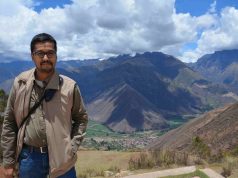 By Kulbhushan Kain
By Kulbhushan Kain
Amba Cinema Hall was never among Delhi’s finest. The seats creaked, the sound crackled, and the carpets had survived more decades than they deserved. But none of that mattered, because Amba was the theatre of the intelligentsia. A short walk from Delhi University’s North Campus, it drew the sharpest young minds. Its verdict could ripple across the country. Word of a film’s brilliance — or collapse — spread like wildfire after every show.
I, too, sat in Amba on a cold February night in 1975, oblivious to the world outside, as a scene unfolded that would redefine my idea of cinematic heroism…
It was played out in a dim, cluttered godown on the Mumbai docks. Peter, the swaggering mafia henchman, ordered his goons to drag in Vijay, so that he could “teach him a lesson”. Vijay the silent and stubborn dockworker had dared to refuse to pay the illegal “hafta”. Minutes later Peter explodes when the goons return empty-handed and inform him, “Vijay bhaag gaya.”
In the pregnant silence of the hall, we waited with bated breath. What next?
And then — the moment that changed everything.
A cold, unhurried baritone sliced through the dusty air: “मैं यहाँ हूँ, Peter. तुम लोग मुझे ढूंढ रहे हो और मैं तुम्हारा यहाँ इंतज़ार कर रहा हूँ।”
The camera turns. Vijay stands there, leaning casually, a beedi shifting between his lips, eyes burning with a quiet storm. Dressed in his coolie uniform, he radiates the stillness of a man who has already decided the fate of the room.
What follows is the turning point of Deewaar. When the godown door finally opens, Vijay staggers out victorious –though battered and bloodied. He barely makes it to a tap, opens it, puts his head under it as his fellow coolie workers cheer him on.
At that moment, Vijay (Amitabh Bachchan) didn’t just walk out of a godown — he walked into cinematic immortality.
But the electricity of that moment owed as much to the man he took on. Peter — played by Kuljeet Singh, was the antagonist who forced Vijay to rise. The villain who made the hero heroic. To this day, no one who has watched Deewaar has forgotten Peter.
Those were the times when the real voltage of Indian cinema didn’t crackle with the hero’s arrival — it detonated with the villain’s entry. Bollywood stood proudly on a dramatic tripod: the hero, the villain, and the comedian. And often, the villain owned the screen. Pran’s icy stare, Amrish Puri’s thunderous voice, Ranjeet’s wicked grin, Ajit’s single-word threats — villains of that era weren’t just characters, they were cultural events.
It was into that arena that Dan Dhanoa strode in majestically.
Tall, broad-shouldered, with light-coloured eyes and rugged charm, public school background, Dan brought a muscular menace that instantly commanded attention. He didn’t just play a bad guy — he inhabited him and made “being bad” look dangerously good.
For me, though, Dan was never just the blazing villain on screen. He was a dear acquaintance — someone I’d known since the ’60s. Our families knew each other long before cinema came calling. Before the arc lights found him, he was Captain Inderpreet Singh Dhanoa — a Doon School boy from 1970 to 1974, and later a Merchant Navy officer navigating oil tankers across the world.
To me he was “Pinchoo.” To his schoolmates he was “Cracky”.
During the global shipping slump of the early ‘80s, Dan suddenly found himself without a job. Most would have panicked. Dan pivoted. He walked into modelling almost by accident — and the camera instantly loved him. His first ad for ELPAR Suitings became a sensation, and soon he had nearly 45 commercials to his name.
Then came a twist straight out of cinema.
Feroz Khan — the ultimate style icon — spotted him at a silver jubilee celebration party at Bombay’s Sea Rock Hotel. He took to Dan, mentored him, and decided to launch him. That film never took off, but Feroz gave him something far more enduring: the name “Dan Dhanoa”.
“Feroz meant a lot to me,” Dan remarked.
“He was straightforward and very caring. He promised he’d do many films with me. He said he saw something special in me.”
His true break followed soon after, when Manmohan Desai cast him as the main villain in Mard. Overnight, Dan became the towering antagonist audiences loved to fear.
What followed was a prolific career — nearly 75 films, including several regional ones. He acted opposite legends: Rajesh Khanna, Amitabh Bachchan, Dharmendra, Naseeruddin Shah, Shashi Kapoor, Pran, Ranjeet, Dilip Kumar, Hema Malini, Rekha — and he held his own every single time.
Recently, I met Dan at his elegant homestay ‘Anchorage 42’, nestled amidst the lush green gardens of Sector 8, Chandigarh. Art is central to the ‘Anchorage 42’ experience. You can admire Indian modern and contemporary art, especially Bengal school works. It is furnished with vintage Art Deco furniture. There is a vast collection of vintage porcelain from Europe, Japan, China, and elsewhere.
“What was Rajesh Khanna like?” I asked, unable to hide the fan boy in me.
“We called him Kaka,” he said with a smile and a faraway look.
“He was surrealistically charismatic. Loved his drink. I dined with him often. He’d top up my glass and say, ‘Dan, your glass is empty!’ He was the finest host I came across. There was something very special about him that can’t be defined,” he added.
I nudged him toward my other favourite — Dev Anand.
“He had that swagger, that voice, that charm — and much more. Young at heart, full of zest, amazing memory, supremely disciplined. I watched him closely when we worked together on Sachche Ka Bol Bala. He would be the first to arrive on the sets.”
I asked him about Amitabh Bachchan and his first film with him.
He smiled at the memory. “During Mard, Manmohan Desai’s juniors tried pushing me around. Amitabh stepped in and said, ‘Why are you bullying him? Just because he’s new? Try that with me.’ That’s the man he is.”
Did he ever feel intimidated, surrounded by such giants?
“Never. It’s the media that makes them superhuman. They’re just like you and me. Amitabh often drove us around in his car. We were in and out of Kaka’s house. Yes, they were different — terrific looking, passionate, great communicators, ambitious — but still human.”
From the disciplined decks of supertankers to modelling and Bollywood sets, his journey has been nothing short of cinematic.
When I asked him what defines him the most — sailor, model, or actor — he smiled.
“All of the above. And more. I’m a collector of art, Art Deco furniture, marine artefacts… a dog lover, a wildlife enthusiast, a lover of classical Indian dance.”
I believe him. I’ve known him too long not to. His homestay reflects it. He was the best sculptor in school and winner of the All India Nehru Yuvak Award. His home is filled with art, antiques, warmth — and the fragrance of good wine. His wife Nandita, a renowned classical dancer, was part of Hema Malini’s celebrated series “Women of India — Amrapali”.
As I bid him goodbye, he smiled with that familiar glint in his eye. He looked at me with the quiet assurance of a man who has lived many lives and lost none of them.
“I never played villains… I played men who refused to be forgotten.”
Outside, dusk was falling over Chandigarh — but something told me that the night still belonged to Dan Dhanoa.
Legends, after all, do not retire; they simply change the room they’re standing in.
(Kulbhushan Kain is an award winning educationist with more than 4 decades of working in schools in India and abroad. He is a prolific writer who loves cricket, travelling and cooking. He can be reached at kulbhushan.kain@gmail.com)








